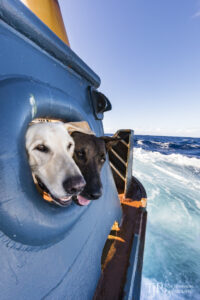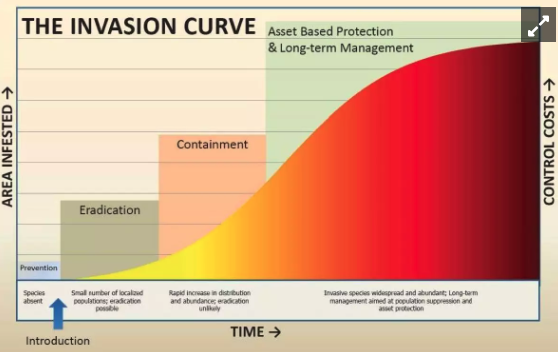October 2025 – History of Our Biosecurity Program
October 2025 – The History of Our Biosecurity Program
By Kyoko Johnson
It all started with my participation in the Crazy Ant Strike Team or CAST. This was a rotating group of US Fish & Wildlife Service volunteers, staff and contractors, who were working to eradicate “yellow crazy ants” or YCA on Johnston Atoll.

YCA is on IUCN’s list of “one hundred of the world’s worst invasive species,” and at Johnston Atoll, they decimated many of the ground-nesting native seabirds and their chicks, with tropicbirds being the main victims. After the accidental introduction of these ants to this island ecosystem, the US Fish & Wildlife Service spearheaded a 10+ year eradication project (read more about it here). At the tail end of said project, I was hired to be a part of CAST XX, or the twentieth crew to deploy to Johnston. I trained two detection dogs, Solo and Guinness, on O‘ahu, then deployed with them to Johnston Atoll in 2020 to help confirm the successful eradication of YCA.

The use of conservation dogs is starting to become more common around the world, including in Hawai‘i, but this was the first time for working dogs to be utilized in the remote island wildlife refuges of Hawaii, other than perhaps Obama’s security detail K9 when they visited Midway. Our YCA project lead Aisha Rickli-Rahman pushed hard to make our deployment a reality despite all of the logistical challenges.
It was an amazing experience to travel to a remote atoll by boat (it took 3 days each way!) and work with my dogs to achieve a conservation goal. It did get me thinking about how these ants were introduced to the atoll in the first place, and how prevention could have saved millions of dollars and countless hours of hard work by CAST.
So naturally, Aisha and I decided to explore the use of biosecurity dogs in Hawai‘i. With the help of mainland organization WD4C, we developed a Powerpoint presentation to pitch the idea to the stakeholders of Papahānaumokuākea (Northwestern Hawaiian Islands) and Pacific Remote Islands Marine National Monuments. Biosecurity dogs are used around the world to detect and prevent the transport of invasive species and other targets that can be harmful to ecosystems. We selected three main targets to focus on: rodents, little fire ants, and yellow crazy ants.

The presentation was well received. And that’s how CDH’s biosecurity program began.
In my follow up article, I’ll share the rest of the story, including how we set up the pilot program, and how the operational work is going now!

